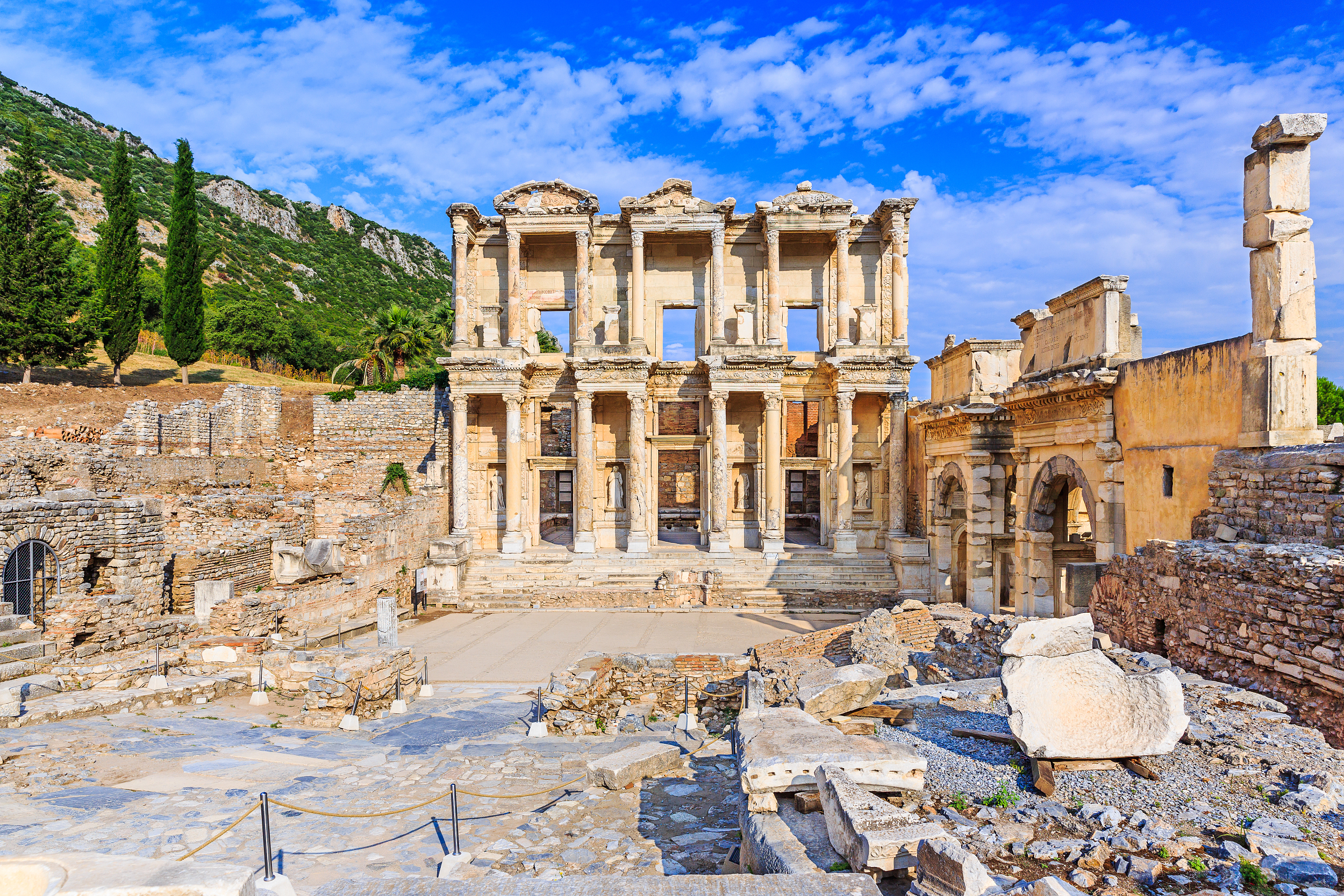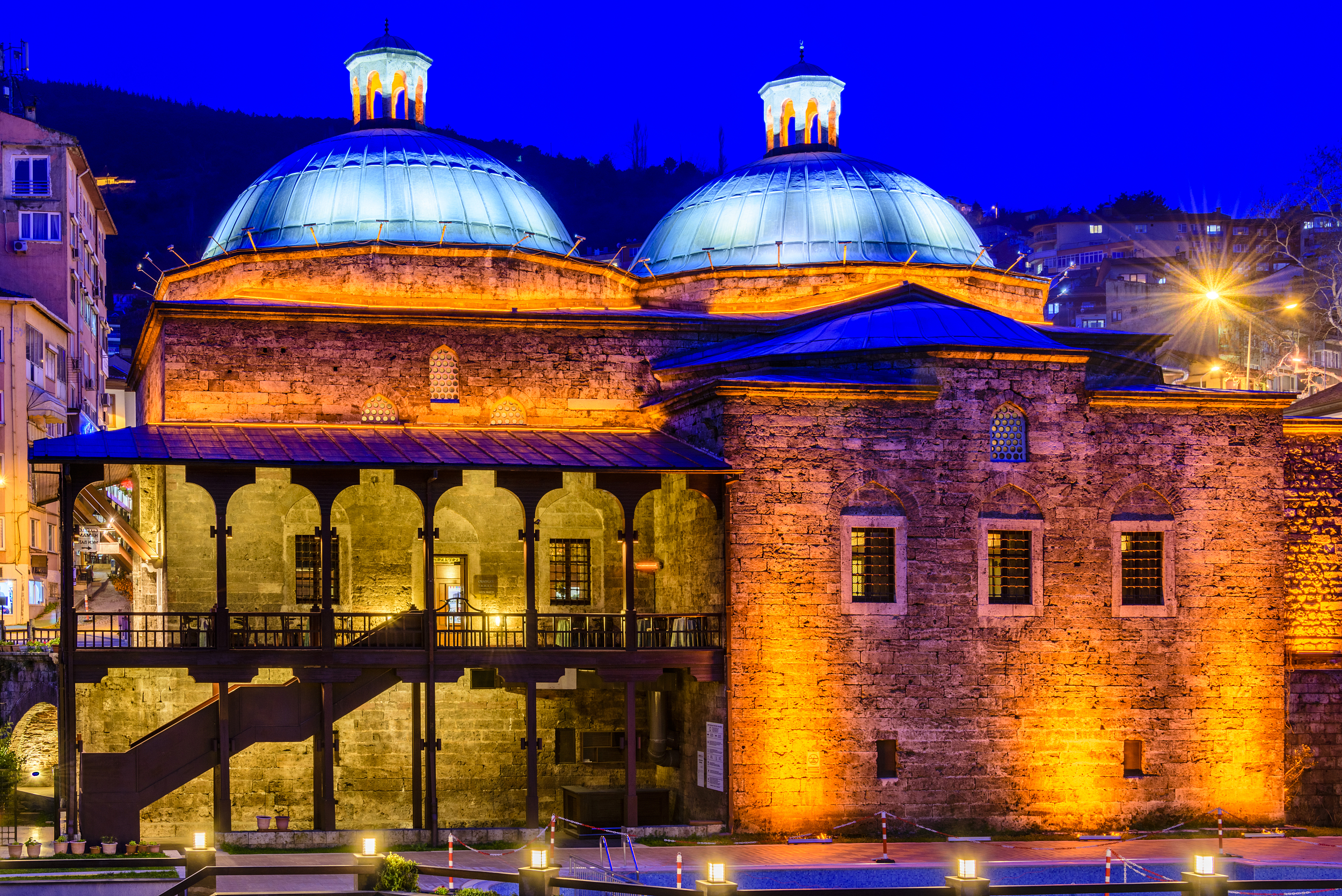https://qa.trip.com/moments/destination-bergama-50061/
App
Customer Support
Find Bookings
2025 Bergama Travel Guide: Must-see attractions, popular food, hotels, transportation routes (updated in July)
Bergama Today's weather
Clear 20-35℃
Popular Attraction in Bergama
Akropolis
(5)All Trip Moments about Bergama
[Ancient Architecture] Baghmen Ancient City: Temple Foundation
#Ancient Architecture The ancient city of Baghmen was once one of the most prosperous ancient cities in ancient Greece and was founded in 281. The ancient city was once the capital of the Roman Empire in Asia, and later the capital was moved to another ancient Turkish city, Ephesus. After experiencing natural disasters such as wars and earthquakes, there are not many buildings left in the mountain city of Baghmon. Now only the foundation of the temple remains in the ancient city, because Germany moved the entire temple away and established the Pergamon Museum. #trip #relax #Turkeyworldtravellover6A family trip to Pergamon, Turkiye
#familytravel We had our family trip to Turkiye, and one of the place we visited is the ancient ruins of Pergamon. Pergamon is a powerful ancient Greek city located at Aeolis, in modern day Bergama. The city flourished during the 400BC during the Hellenistic period, and it has been in a bustling state until the invasion of the Seljuks. Today, the upper Acropolis consists of several pillars which forms the original Traianeum, and the Pergamon Altar, is currently on display at the Pergamon Museum in Berlin. There is also an amphitheater similar to other Greek ancient cities. The most interesting part is that this area is mentioned in the Bible as one of the seven churches in the books of Revelations.johnswj904Pergamon Ancient City 🏛️🇹🇷
#timetotravel My visit to the Ancient City of Pergamon in Turkey was nothing short of awe-inspiring. Perched atop a steep hill, the ruins of Pergamon offer a breathtaking panorama of history and nature. The Acropolis of Pergamon is a testament to the city's ancient glory. The grand theater, one of the steepest in the ancient world, left me speechless. Imagining the performances that once unfolded here was a vivid experience. The Altar of Zeus, now housed in Berlin's Pergamon Museum, once stood here, a symbol of Pergamon's artistic and cultural achievements. Wandering through the ancient streets, I marveled at the well-preserved remains of temples, libraries, and houses. The Asclepius Sanctuary, dedicated to the god of healing, was particularly impressive. Pergamon's rich history and its commanding position overlooking the plains make it a must-visit for history buffs and those seeking to immerse themselves in the grandeur of antiquity. #izmir #bergama #turkiyeFlorinM13[Türkiye Aegean Sea] The world's only arc-shaped theater for 10,000 people, the imperial capital of Pergamon
The ruins of Pergamon stand on a towering mountain top that is ancient and magnificent. It was once the imperial capital of the Roman period! When you walk up, you can not only overlook the entire city, but also enjoy the beautiful view of the Aegean Sea. Trying to imagine the scene during the heyday of the empire, one can’t help but marvel at the rapid and great progress of human civilization. #Turkey #Aegean Sea #Pergamon #Ruins #Mountaintop #Theater #Roman Empire카렌KAREN14Acropolis of Pergamon
The Acropolis of Pergamum (Pergamon) is the one of the oldest archaeological sites that you can not miss if you are in Bergama. The whole visit, including walking around and taking pictures should last between 2 to 3 hours. Most of the temple are basically ruins that has been partially reconstructed. It is more comfortable to visit this place in the morning or late afternoon as the weather is quite hot. There is a lot of walking and climbing to do if you want to properly explore the place. So plan ahead to dress comfortably specially good walking shoes and WATER! There are some souvenir and refreshment shops in case you need to do some shopping. #createwithtrip #turkey #holidays #exploring #createwithtripRafael Osorio6Hera Hotel Bergama: A hotel in an ancient city reminiscent of ruins
This hotel has a great atmosphere and is located in a 200-year-old, stately Greek building in the World Heritage city of Bergama. Just being in the room makes you feel like a resident of the ruins. I enjoyed a sumptuous breakfast while looking out at the beautiful cityscape. It's the perfect base for a trip to the Acropolis and Asklepion, both World Heritage sites. The hotel also introduced us to some delicious restaurants nearby. #gourmetfood #worldheritage #gourmettrip目指せ11832The remains of the Roman Empire: the Acropolis of Bergama
The Acropolis of Bergama is a World Heritage Site. The Great Altar of Zeus, which was originally located here, was taken away along with the building and is now in the Pergamon Museum in Berlin. Only the foundation remains (third photo). There are plenty of sights to see, including a large theater and temple ruins. #WorldHeritage #Heritage #BreathtakingView目指せ1188Ancient Medical and Health Center Asklepion (Türkiye)
The remains of a Roman medical and health facility, designated as a UNESCO World Heritage Site. Located close to the center of Bergama, I was able to relax after my trip by looking around the snake sculptures, which are symbols of rebirth, and the theater and tunnels where treatments were likely carried out.目指せ1187A journey to experience the wisdom and beauty of ancient Greece at the Pergamon ruins, a library and theater in the sky.
#AbsolutelyFreeTrip A trip to experience the wisdom and beauty of ancient Greece at the Pergamon ruins, a library and theater in the sky. Located in Bergama in western Turkey, the Pergamon ruins are the city where ancient Greek knowledge and art flourished. Flourished around the 2nd century BC, this place once had one of the world's largest libraries and was known as a center of medicine and philosophy. 📚 The ruins that spread out on the hill are truly a "city in the sky." In particular, the theater built on the steep slope is a masterpiece, and just imagining the lives of ancient people with the view below will make your heart tremble. There are also many attractions, such as the Acropolis (fortress ruins) and the remains of the altar of Zeus. If you visit as a couple, the time you spend talking in the quiet ruins will be special. Even if you travel alone, you can spend luxurious time facing history while being blown by the wind. "I can't believe there are such magnificent and beautiful ruins in Turkey..." I was so impressed✨ 🚗Access The nearest city is Izmir. It takes about an hour and a half by car from Izmir Airport to Bergama. You can access the ruins from the city by taxi or tour. Pergamon Ruins #Bergama #Ancient Greece #Theater in the Sky #Overseas Travel #Couple Travel #Solo Travel旅するOLたにさんThis must be the most magnificent ancient city ruins I've ever visited.
Pergamon, known as Pergamon in ancient times, the city of Asclepius the healing god, and hometown of Galen, the most famous physician and theorist of ancient Rome. From being the "Second Athens" of the Attalid dynasty during the Hellenistic period to becoming a "metropolis" during Hadrian's era. It boasts the steepest and most precipitous theater in the ancient world (Figure 1), which feels even more spectacular than the theaters at the Acropolis of Athens and Delphi in Greece, with terrain comparable to the ancient theater in Taormina, Sicily, Italy. Above the theater stands the massive architectural structure of the Trajan Temple (Figures 2, 3), along with the palace ruins of Hellenistic kings. The most famous structure on the Acropolis is undoubtedly the Hellenistic "Altar of Zeus," now reduced to ruins (Figures 5, 6, 7). Its exquisite frieze depicts the ancient gods' "Battle of the Giants," a masterpiece of Hellenistic art. The frieze panels and some decorative elements were taken to Berlin by a German archaeological team in the 19th century, becoming the most important collection of the Pergamon Museum. There are also the temples of Asclepius, Dionysus, and Athena at the foot of the hill... and the "Red Basilica," the largest structure in the Greek world during ancient Roman times, likely sponsored by Emperor Hadrian (Figure 8). The Pergamon Acropolis, with its architectural diversity and rigorous layout, became a model of classical urban expansion planned in stages. After the end of the classical era, the city experienced several rises and falls. During the Byzantine period, walls and churches were built, and in the 13th and 14th centuries, it suffered Seljuk raids and earthquakes. By the Ottoman period, the Acropolis and other ancient structures were abandoned, and a series of settlements were established at the foot of the hill. Pergamon was inscribed on the UNESCO World Heritage List for its layered cultural landscape and historical significance, with the following evaluation: Rising above the plains of Turkey's Aegean region, the Pergamon Acropolis was the capital of the Hellenistic Attalid dynasty and a major academic center of the ancient world. Monumental temples, theaters, stoas or arches, gymnasiums, altars, and libraries were built on the steep slopes of the hill, surrounded by a massive wall. Later, the city became the capital of the Roman province of Asia, renowned for its Asclepeion healing center. The summit of the Acropolis presents a multi-layered landscape featuring remains from the Roman, Byzantine, and Ottoman empires, overlooking the western Anatolian plains.HenryFrost23TURKIYE | 🏛️ Close to the sky, far away in time – Acropolis, Bergama 🌬️🌄
#Overseas travel #Acropolis #Bergama #Ancient breath #Turkish ruins #Walk above time #Turkiye travel I slowly climbed up the hill following the wind. There, a city where time seemed to have stopped, the ruins closest to the sky, the Acropolis, were spread out. Sunlight seeping through the collapsed pillars, sitting on a rock and looking at the distant scenery, I thought about how this was a place where people lived thousands of years ago, and a part of my heart quietly rang. 🕊️🏛️ Even the strong wind and the fallen pillars could not erase the weight of this place. Instead, it seemed to be engraved more deeply. I walked through the ruins as if taking a walk, and I wondered for a moment whether my footsteps could become someone's memories someday. The Acropolis may not be flashy, but it was a solid, quiet, and long-lasting landscape. In the place where time stopped, I also stayed for a long time. 🌿⏳0do_soGods and Imperial Power in the Mongol City of Pergamon
Visiting the ruins of the ancient city of Pergamon in Izmir, Turkey, I was deeply moved by its vicissitudes of history and the accumulation of culture. It is the most worthwhile ruins to visit. This ancient city has witnessed the glory and decline of the past. Every stone and every piece of rubble seems to be telling stories of the past. Standing in the ruins, I felt the weight of history and also experienced the fragility and tenacity of human civilization. This trip gave me a deeper understanding of Turkey's history and culture. #GlobalTravel #Turkey #IzmirMiamiayaThe Temple of Asclepius in Bergama
The Temple of Asclepius (Asclepion) was built in the 4th century BC, dedicated to the god of medicine, Asclepius. During the Roman times, it became a medical center. The temple complex included the Sanctuary of Asclepius, a courtyard with a colonnade, a theater that could accommodate 3500 people, a ceremonial hall belonging to the Roman Emperor Hadrian, and on the south side of the Temple of Asclepius, there were three ancient Greek temples, bedrooms, springs and ponds. The Temple of Asclepius was known as 'a place where death is forbidden to enter', and the snake-shaped column, a symbol of medicine, stood next to the sacred road. Next to the sacred spring of the temple, there was an underground passage specifically for patients to avoid the heat and cold. Before becoming a court doctor, the famous medical scientist Galenos of the Roman times had been working in this temple.BRIANNA MORALESHistory Butterfly Belly-Türkiye 2️⃣
#Pergamon is an ancient city full of history located in Izmir Province in western Turkey. The city dates back to the 3rd century BC and was a political, economic and cultural center during the ancient Greek and Roman eras. The ancient city of Baghmen contains many attractions. You should do your homework before arriving, otherwise you will need to ask a tour guide for explanation. The relic that impressed me the most was the ancient theater, which could accommodate about 10,000 people. You can see the high and sloping Roman forum. The height and slope scared me. It was the main place for drama and music performances at that time. Another thing that impressed me was the library, which was said to have been the second largest library in the world at that time, second only to the Library of Alexandria. This ancient city is also the birthplace of parchment. After more than 3,000 years of time and the baptism of war, although it has become a ruin and a pile of rocks, it still retains its grandeur and the scenery is first-class!大牧羊仔仔2Bagh Gate Ancient City
#NewYearGoodDestinations Baghmon is a historical site in Bergama, Türkiye. The ancient city is an acropolis located on a high mountain. It was once one of the most prosperous ancient cities in ancient Greece, and archaeologists have found some ancient relics proving that it was the first place inhabited by humans in the Stone Age. Visit the ancient city 📸, and overlook the beautiful scenery below the mountain 💯📸. #TurkeyTravel #TurkeyAttractions #NewYearGoodDestinations陌上行6Acropolis
Acropolis , the best place to visit with your family in athens💕GreektravelerAncient Greek city not in Greece
Izmir is a seaside resort city in Turkey because a little outside is the Aegean Sea, popular with locals and tourists alike. In fact, there is the city of Pergamon Antik Kenti is a well-preserved ancient site, with shrines, altars, theaters, libraries of incomplete ruins, complete sculptures and beams have been moved early to Berlin Pergamon Museum exhibition. Like Greece is due to the golden period of ancient Greece, there were many city-states, all colonial cities established by the Greeks, including Izmir, completely occupied by Greek culture. Unlike the style of Ephesus, it really looks a bit like the Parthenon in Athens, so it's beautiful to take picturesmybambam6Izmir City
#izmir #beachlife Izmir counts one of the biggest cities in Turkey. Izmir is famous for its beautiful weather beaches and cafes. Visitor around the world comes to Izmir mostly in summer vacations.Xahid Khan1

Popular Bergama Topics

2025 Recommended Attractions in Bergama (Updated July)
19 posts

2025 Recommended Guides in Bergama (Updated July)
4 posts

Destinations related to Bergama

2025 Selcuk Travel Guide: Must-see attractions, popular food, hotels, transportation routes (updated in July)
183 posts

2025 Izmir Travel Guide: Must-see attractions, popular food, hotels, transportation routes (updated in July)
110 posts

2025 Bursa Travel Guide: Must-see attractions, popular food, hotels, transportation routes (updated in July)
31 posts
Post
More Recommendations
Popular Trip Moments
A journey to experience the wisdom and beauty of ancient Greece at the Pergamon ruins, a library and theater in the sky. | This must be the most magnificent ancient city ruins I've ever visited. | TURKIYE | 🏛️ Close to the sky, far away in time – Acropolis, Bergama 🌬️🌄 | Acropolis | Gods and Imperial Power in the Mongol City of Pergamon | Explore the Acropolis and Feel the Breath of History | [Ancient Architecture] Baghmen Ancient City: Temple Foundation | A family trip to Pergamon, Turkiye | The Temple of Asclepius in Bergama | Pergamon Ancient City 🏛️🇹🇷 | History Butterfly Belly-Türkiye 2️⃣ | Bagh Gate Ancient City | Acropolis | Ancient Greek city not in Greece | [Türkiye Aegean Sea] The world's only arc-shaped theater for 10,000 people, the imperial capital of Pergamon | Izmir City | Acropolis of Pergamon | Hera Hotel Bergama: A hotel in an ancient city reminiscent of ruins | The remains of the Roman Empire: the Acropolis of Bergama | Ancient Medical and Health Center Asklepion (Türkiye)
Recommended Attractions at Popular Destinations
Popular Attractions in Bangkok | Popular Attractions in Manila | Popular Attractions in Tokyo | Popular Attractions in Taipei | Popular Attractions in Hong Kong | Popular Attractions in Seoul | Popular Attractions in Kuala Lumpur | Popular Attractions in Los Angeles | Popular Attractions in Shanghai | Popular Attractions in New York | Popular Attractions in Shenzhen | Popular Attractions in Osaka | Popular Attractions in Singapore | Popular Attractions in London | Popular Attractions in Guangzhou | Popular Attractions in San Francisco | Popular Attractions in Beijing | Popular Attractions in Macau | Popular Attractions in Bali | Popular Attractions in Jakarta | Popular Attractions in Paris | Popular Attractions in Ho Chi Minh City | Popular Attractions in Istanbul | Popular Attractions in Phuket | Popular Attractions in Chicago | Popular Attractions in Seattle | Popular Attractions in Toronto | Popular Attractions in Orlando | Popular Attractions in Cebu | Popular Attractions in Chiang Mai
Popular Restaurants in Bergama
Bahçe Cafe & Bar | Arzu Pide | Saglam Restaurant | Gonul Cafe | Arasta Kahvalti Lokanta Cafe | Asklepion Restaurant | Cafe Pinea | Bergama Ticaret Odasi Sosal Tesisleri | Caravan Camping and Restaurant | Q-BA | Kervan Pita Kebab & Doner Restaurant | Zeus Birahanesi | Bolulu Hasan Usta Sut TatlIlarI Bergama | Selale Pide Pizza Kabap Salonu | Kozak Kafe | Cennet Bahcesi | Red Basilica | Bergama Efe Restaurant | Kozak Cinar Restaurant Cafe | Altin Kepce Bergama Meatball | Bergama Sofrasi | Babadan Baklava | Kybele Restaurant | Kizilcik Kafe | Ciceksever | SARMAŞIK LOKANTASI (KÖYLÜMÜN YERİ) | Harun Ergurbuz | Kuplu Hamam Cafe | Pala Kebab Restaurant | Evim
Popular Ranked Lists
Popular Luxury Hotels Near Port Macquarie | Top 50 Luxury Hotels near Costa Occidental | Popular Luxury Hotels Near Smaliavichy District | Top 50 Must-Visit Restaurants in Suzhou | Top 50 Must-Visit Restaurants in Fuzhou | Top 50 Must-Visit Restaurants in Washington D.C. | Popular Best Things to Do in Daqing | Popular Premium Hotels in Alghero | Top 50 Must-Visit Restaurants in Langkawi | Top 50 Must-Visit Restaurants in Kuala Lumpur | Popular Luxury Hotels Near Prienai District Municipality | Popular Best Things to Do in Zhongxiang | Popular Best Things to Do in Ankang | Top 10 Best Things to Do in Tianshui | Top 50 Must-Visit Restaurants in Zhuhai | Top 10 Trending Attractions in Jeju | Top 50 Must-Visit Restaurants in Rome | Top 10 Best Things to Do in Glasgow | Top 50 Must-Visit Restaurants in Santorini | Top 50 Must-Visit Restaurants in Foshan | Top 50 Must-Visit Restaurants in Seattle | Top 50 Must-Visit Restaurants in Chengdu | Top 50 Must-Visit Restaurants in Nha Trang | Top 20 Best Things to Do in Birmingham | Top 10 Trending Attractions in Yangshuo | Top 50 Must-Visit Restaurants in Beijing | Top 10 Best Things to Do in Jincheng | Popular Premium Hotels in Oakland | Popular Luxury Hotels Near Miri | Popular Best Things to Do in Duyun
About
Payment Methods
Our Partners
Copyright © 2025 Trip.com Travel Singapore Pte. Ltd. All rights reserved
Site Operator: Trip.com Travel Singapore Pte. Ltd.
Site Operator: Trip.com Travel Singapore Pte. Ltd.